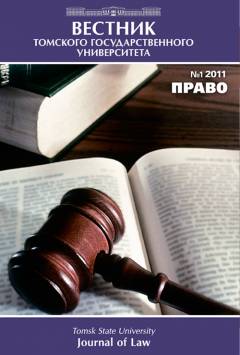On the structure of the burden of proof
The burden of proof includes the obtaining and use of evidence to reconstruct real circumstances of the event under study; it is the only means for the protection of rights and legal interests of the injured party and protects a person against illegal criminal liability and restriction of his/her rights and freedoms. It is impossible to adjudicate social conflicts in the field of law without the burden of proof. Therefore, the burden of proof has always been and still is the heart of criminal procedure. Meanwhile, the development of national legislation gave rise to different positions connected with the structure of evidence. The Criminal Procedure Code of the Russian Federation 2001, Article 85 has stated that the process of proof includes collection, examination and evaluation of evidence. The authors point out that none of the above constituent part got a detailed legislative regulation and this resulted in the discussion about their content and correlation with each other. It has been noted in the present article that verification of evidence is a central element of the burden of proof. The authors give a critical analysis of the opposite viewpoint (it is the examination of evidence that is a central element) and come to the conclusion that in this case examination of evidence is understood as collection of evidence and its evaluation, but this is inadmissible. Moreover, the problem of the structure of the burden of proof is solved in the legislation of foreign states in different ways. The article examines the renewed criminal procedure legislations in the countries of CIS and their interpretation of verification of evidence. According to the Criminal Procedure Codes of the Republic of Moldova (Article 100), Republic of Tajikistan (Article 87), Kyrgyz Republic (Article 92), Azerbaijan Republic (Article 144) the verification of evidence has no procedural character but is a constituent element of the collection of evidence. The Criminal Procedure Codes of Kazakhstan (Article 124) and Turkmenistan (Article 135) name the above element as "examination of evidence". On the whole the Criminal Procedure Codes of CIS interpret the examination of evidence loosely, the analysis of collected evidence being included into it. The authors come to the conclusion that all elements of the burden of proof are tightly intertwined and interpenetrated but examination of evidence has an independent character. Unlike other elements its purpose is to obtain some supplementary materials which at the final stage of burden of proof enable us to define whether the obtained evidence has all necessary characteristics and is able to supplement the set of other collected evidence.
Keywords
процесс доказывания, собирание доказательств, проверка доказательств, оценка доказательств, исследование доказательств, burden of proof, collection of evidence, verification of evidence, evaluation of evidence, examination of evidenceAuthors
| Name | Organization | |
| Shaifer Semyon A. | Samara National Research University | univer_ tgu@rambler.ru |
| Nikolaeva Ksenia A. | Samara National Research University |
References

On the structure of the burden of proof | Tomsk State University Journal of Law. 2016. № 2(20).